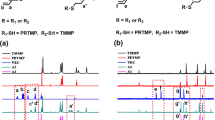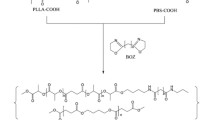Abstract
Bio-based polyurethane materials are broadly applied in medicine as drug delivery systems. Nevertheless, their synthesis comprises the use of petroleum-based toxic amines, isocyanates and polyols, and their biocompatibility or functionalization is limited. Therefore, the use of lysine residues as amine sources to create non-isocyanate urethane (NIU) linkages was investigated. Therefore, a five-membered biscyclic carbonate (BCC) was firstly synthetized and reacted with a protected lysine, a tripeptide and a heptapeptide to confirm the urethane linkage formation with lysine moiety and to optimize reaction conditions. Afterwards, the reactions between BCC and a model protein, elastin-like protein (ELP), and β-Lactoglobulin (BLG) obtained from whey protein, respectively, were performed. The synthesized protein materials were structural, thermally and morphologically characterized to confirm the urethane linkage formation. The results demonstrate that using both simple and more complex source of amines (lysine), urethane linkages were effectively achieved. This pioneering approach opens the possibility of using proteins to develop non-isocyanate polyurethanes (NIPUs) with tailored properties.













Similar content being viewed by others
References
Bähr M, Mülhaupt R (2012) Linseed and soybean oil-based polyurethanes prepared via the non-isocyanate route and catalytic carbon dioxide conversion. Green Chem 14:483–489
Bernardim B, Cal PMSD, Matos MJ, Oliveira BL, Martínez-Sáez N, Albuquerque IS, Perkins E, Corzana F, Burtoloso ACB, Jiménez-Osés G (2016) Stoichiometric and irreversible cysteine-selective protein modification using carbonylacrylic reagents. Nat Commun 7:13128
Booysen J, Marx S, Muller LC. Vermeulen U, Grobler A (2015) Synthesis of novel non-isocyanate polyhydroxyurethane from l-lysine and its application. In: 7th International Conference on Latest Trends in Engineering & Technology, pp 184–190
Brown J, Davidowski S, Xu D, Cebe P, Onofrei D, Holland G, Kaplan D (2016) Thermal and structural properties of silk biomaterials plasticized by glycerol. Biomacromol 17:3911–3921
Burke A, Hasirci N (2004) Polyurethanes in biomedical applications. Adv Exp Med Biol 553:83–101
Butnaru M, Bredetean O, Macocinschi D, Dimitriu CD, Knieling L, Harabagiu V (2012) Biocompatibility and biological performance of the improved polyurethane membranes for medical applications. Polyurethane 10:201–228
Carré C, Bonnet L, Avérous L (2015) Solvent- and catalyst-free synthesis of fully biobased nonisocyanate polyurethanes with different macromolecular architectures. RSC Adv 5:100390–100400
Carré C, Zoccheddu H, Delalande S, Pichon P, Avérous L (2016) Synthesis and characterization of advanced biobased thermoplastic nonisocyanate polyurethanes, with controlled aromatic-aliphatic architectures. Eur Polym J 84:759–769
Chan WY, Bochenski T, Schmidt JE, Olsen BD (2017) Peptide domains as reinforcement in protein-based elastomers. ACS Sustain Chem Eng 5:8568–8578
Cobo I, Li M, Sumerlin BS, Perrier S (2014) Smart hybrid materials by conjugation of responsive polymers to biomacromolecules. Nat Mater 14:143
Cornille A, Dworakowska S, Bogdal D, Boutevin B, Caillol S (2015) A new way of creating cellular polyurethane materials: NIPU foams. Eur Polym J 66:129–138
Cornille A, Guillet C, Benyahya S, Negrell C, Boutevin B, Caillol S (2016) Room temperature flexible isocyanate-free polyurethane foams. Eur Polym J 84:873–888
Cornille A, Auvergne R, Figovsky O, Boutevin B, Caillol S (2017) A perspective approach to sustainable routes for non-isocyanate polyurethanes. Eur Polym J 87:535–552
Elena D, Vincent F, Guillaume M, Frédéric S, Rémi A, Stéphane F, Sylvain C (2016) Thermoresponsive crosslinked isocyanate-free polyurethanes by Diels-Alder polymerization. J Appl Polym Sci 134:44408–44419
Fabian H, Mäntele W (2006) Infrared spectroscopy of proteins. Handbook of Vibrational Spectroscopy. Biochem Appl 2006:3399–3425
Gerard L (2014) Renewable polyols for polyurethane synthesis via thiol-ene/yne couplings of plant oils. Macromol Chem Phys 214:415–422
Gonzales M, Simon J, Ghoorchian A, Scholl Z, Lin S, Rubinstein M, Marszalek P, Chilkoti A, López G, Zhao X (2017) Strong, tough, stretchable, and self-adhesive hydrogels from intrinsically unstructured proteins. Adv Mater 29:1604743
Hannes B, Maria F, Moritz B, Rolf M (2014) Isocyanate- and phosgene-free routes to polyfunctional cyclic carbonates and green polyurethanes by fixation of carbon dioxide. Macromol Rapid Commun 35:1238–1254
Hu X, Cebe P, Weiss AS, Omenetto F, Kaplan DL (2012) Protein-based composite materials. Mater Today 15:208–215
Istanbullu H, Ahmed S, Sheraz MA, Rehman I (2013) Development and characterization of novel polyurethane films impregnated with tolfenamic acid for therapeutic applications. Biomed Res Int 2013:1–8
Kihara N, Kushida Y, Endo T (1996) Cyclic carbonate and l-lysine derivatives. J Polym Sci 34:2173–2179
Kreye O, Mutlu H, Meier MAR (2013) Sustainable routes to polyurethane precursors. Green Chem 15:1431–1455
Lligadas G, Ronda JC, Galià M, Cadiz V (2010) Oleic and undecylenic acids as renewable feedstocks in the synthesis of polyols and polyurethanes. Polymers 2(4):440–453
Machado R, Da Costa A, Sencadas V, Pereira AM, Collins T, Rodríguez-Cabello JC, Lanceros-Méndez S, Casal M (2015) Exploring the properties of genetically engineered silk-elastin-like protein films. Macromol Biosci 15:1698–1709
Macocinschi D, Filip D, Vlad S, Tuchilus CG, Cristian AF, Barboiu M (2014) Polyurethane/β-cyclodextrin/ciprofloxacin composite films for possible medical coatings with antibacterial properties. J. Mater. Chem. B 2(6):681–690
Maisonneuve L, Lamarzelle O, Rix E, Grau E, Cramail H (2015) Isocyanate-free routes to polyurethanes and poly (hydroxy urethane). S Chem Rev 115:12407–12439
Mallakpour S, Rafiee Z (2008) Use of ionic liquid and microwave irradiation as a convenient, rapid and eco-friendly method for synthesis of novel optically active and thermally stable aromatic polyamides containing N-phthaloyl-l-alanine pendent group. Polym Degrad Stab 93:753–759
Mallakpour S, Tirgir F, Sabzalian MR (2010) Novel biobased polyurethanes synthesized from nontoxic phenolic diol containing l-tyrosine moiety under green media. J Polym Environ 18:685–695
Namazi H (2017) Polymers in our daily life. Bioimpacts 7:7374
Olsen B (2013) Engineering materials from proteins. AIChE J 59:3558–3568
Poussard L, Mariage J, Grignard B, Detrembleur C, Jéroîme C, Calberg C, Heinrichs B, De Winter J, Gerbaux P, Raquez JM (2016) Non-isocyanate polyurethanes from carbonated soybean oil using monomeric or oligomeric diamines to achieve thermosets or thermoplastics. Macromolecules 49:2162–2171
Ramos Ó, Reinas I, Silva S, Fernandes J, Cerqueira M, Pereira R, Vicente A, Poças F, Pintado M, Malcata X (2013) Effect of whey protein purity and glycerol content upon physical properties of edible films manufactured therefrom. Food Hydrocoll 30:110–122
Rokickia G, Parzuchowskia PG, Magdalena M (2015) Non-isocyanate polyurethanes: synthesis, properties and applications. Polym Adv Technol 26:707–761
Silva NHCS, Vilela C, Marrucho IM, Freire CSR, Pascoal Neto C, Silvestre AJD (2014) Protein-based materials: from sources to innovative sustainable materials for biomedical applications. J Mater Chem B 2:3715–3740
Spicer CD, Davis BG (2014) Selective chemical protein modification. Nat Commun 5:4740
Thomas S, Datta J, Haponiuk J, Reghunadhan A (2017) Polyurethane polymers: composites and nanocomposites, 1st edn. Elsevier, Amsterdam
van Velthoven J, Gootjes L, van Es D, Noordover B, Meuldijk J (2015) Poly(hydroxyurethane)s based on renewable diglycerol dicarbonate. Eur Polym J 70:125–135
Wang F, Yang C, Hu X (2014) Advanced protein composite materials. In lightweight materials from biopolymers and biofibers. ACS Symposium Series 1175:177–208
Wang C, Zheng Y, Sun Y, Fan J, Qin Q, Zhao Z (2016) A novel biodegradable Polyurethane based on poly(3-hydroxybutyrate-co-3-hydroxyvalerate) and poly(ethylene glycol) as promising biomaterials with the improvement of mechanical properties and hemocompatibility. Polym Chem 7:6120–6132
Worm B, Lotze HK, Jubinville I, Wilcox C, Jambeck J (2017) Plastic as a persistent marine pollutant. Annu Rev Environ Resour 42:1–26
Acknowledgements
TSSIPRO—Technologies For Sustainable And Smart Innovative Products, NORTE-01-0145-FEDER-000015 and COMPETE 2020 Programme and National Funds through FCT—Portuguese Foundation for Science and Technology under the project UID/CTM/50025/2013. The authors would like to thank Professor Sílvia Lima and Professor Susana Costa from the Chemistry Department at the University of Minho for kindly allow the use of Microwave CEM Discover SPS equipment and for all knowledge shared during this work.
Author information
Authors and Affiliations
Corresponding author
Ethics declarations
Conflict of interest
The authors declare that they have no conflict of interest.
Research involving human participants and/or animals
This research did not involve human participants or animals.
Informed consent
None.
Additional information
Handling Editor: F. Albericio.
Publisher's Note
Springer Nature remains neutral with regard to jurisdictional claims in published maps and institutional affiliations.
Electronic supplementary material
Below is the link to the electronic supplementary material.
Rights and permissions
About this article
Cite this article
Peixoto, C., Soares, A.M.S., Araújo, A. et al. Non-isocyanate urethane linkage formation using l-lysine residues as amine sources. Amino Acids 51, 1323–1335 (2019). https://doi.org/10.1007/s00726-019-02770-x
Received:
Accepted:
Published:
Issue Date:
DOI: https://doi.org/10.1007/s00726-019-02770-x




